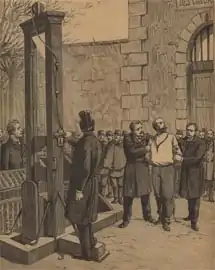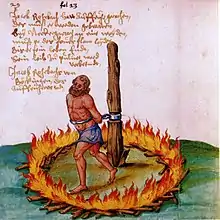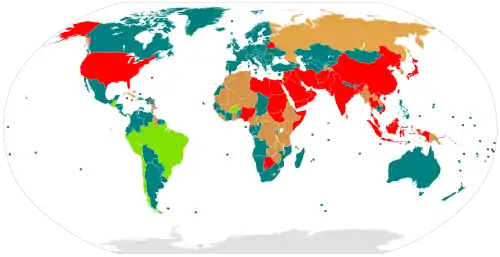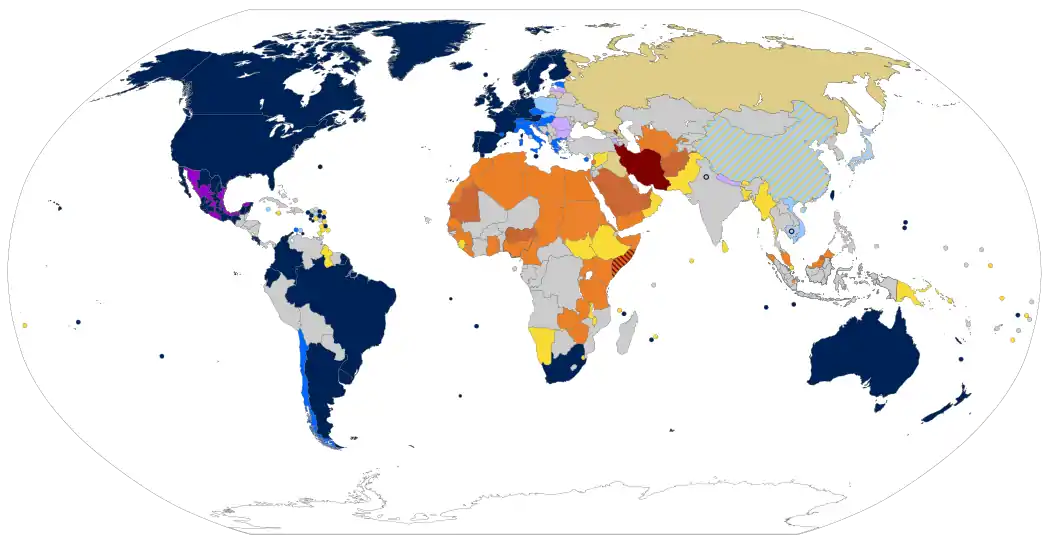Capital punishment
Capital punishment, also known as the death penalty, is the state-sanctioned homicide of a person as punishment for a crime. The sentence ordering that someone is punished with the death penalty is called a death sentence, and the act of carrying out such a sentence is known as an execution. A prisoner awaiting his or her execution is condemned and is "on death row". Crimes that are punishable by death are known as capital crimes, capital offences or capital felonies, and vary depending on the jurisdiction, but commonly include serious crimes against the person such as murder, mass murder, aggravated cases of rape, child rape, child sexual abuse, terrorism, war crimes, crimes against humanity, and genocide, along with crimes against the state including, but not limited to, attempting to overthrow government, treason, espionage, sedition, piracy, and aircraft hijacking. Also, in some cases, acts of recidivism, aggravated robbery, and kidnapping, in addition to drug trafficking, drug dealing, and drug possession, are capital crimes or enhancements.
| Criminal procedure |
|---|
| Criminal trials and convictions |
| Rights of the accused |
| Verdict |
| Sentencing |
|
| Post-sentencing |
|
| Related areas of law |
|
| Portals |
|
|
Etymologically, the term capital (lit. "of the head", derived via the Latin capitalis from caput, "head") describes execution by beheading,[1] but executions are carried out by many methods including hanging, shooting, lethal injection, stoning, electrocution and gassing.
48 countries retain capital punishment, 108 countries have completely abolished it de jure for all crimes, seven have abolished it for ordinary crimes (while maintaining it for special circumstances such as war crimes), and 28 are abolitionist in practice.[2] Although most nations have abolished capital punishment, over 60% of the world's population live in countries where the death penalty is retained, such as China, India, the United States, Indonesia, Pakistan, Bangladesh, Nigeria, Egypt, Saudi Arabia, Iran, as well as in Japan and Taiwan.[3][4][5][6][7]
Capital punishment is controversial in several countries and states, and positions can vary within a single political ideology or cultural region. In the European Union (EU), Article 2 of the Charter of Fundamental Rights of the European Union prohibits the use of capital punishment.[8] The Council of Europe, which has 47 member states, has sought to abolish the use of the death penalty by its members absolutely, through Protocol 13 of the European Convention on Human Rights. However, this only affects those member states which have signed and ratified it, and they do not include Armenia, Russia, and Azerbaijan. The United Nations General Assembly has adopted, throughout the years from 2007 to 2018,[9] seven non-binding resolutions calling for a global moratorium on executions, with a view to eventual abolition.[10]
History

Execution of criminals and dissidents has been used by nearly all societies since the beginning of civilizations on Earth.[11] Until the nineteenth century, without developed prison systems, there was frequently no workable alternative to ensure deterrence and incapacitation of criminals.[12] In pre-modern times the executions themselves often involved torture with cruel and painful methods, such as the breaking wheel, keelhauling, sawing, hanging, drawing, and quartering, burning at the stake, flaying, slow slicing, boiling alive, impalement, mazzatello, blowing from a gun, schwedentrunk, and scaphism. Other methods which appear only in legend include the blood eagle and brazen bull.
The use of formal execution extends to the beginning of recorded history. Most historical records and various primitive tribal practices indicate that the death penalty was a part of their justice system. Communal punishments for wrongdoing generally included blood money compensation by the wrongdoer, corporal punishment, shunning, banishment and execution. In tribal societies, compensation and shunning were often considered enough as a form of justice.[13] The response to crimes committed by neighbouring tribes, clans or communities included a formal apology, compensation, blood feuds, and tribal warfare.
A blood feud or vendetta occurs when arbitration between families or tribes fails or an arbitration system is non-existent. This form of justice was common before the emergence of an arbitration system based on state or organized religion. It may result from crime, land disputes or a code of honour. "Acts of retaliation underscore the ability of the social collective to defend itself and demonstrate to enemies (as well as potential allies) that injury to property, rights, or the person will not go unpunished."[14]
In most countries that practise capital punishment, it is now reserved for murder, terrorism, war crimes, espionage, treason, or as part of military justice. In some countries sexual crimes, such as rape, fornication, adultery, incest, sodomy, and bestiality carry the death penalty, as do religious crimes such as Hudud, Zina, and Qisas crimes, such as apostasy (formal renunciation of the state religion), blasphemy, moharebeh, hirabah, Fasad, Mofsed-e-filarz and witchcraft. In many countries that use the death penalty, drug trafficking and often drug possession is also a capital offence. In China, human trafficking and serious cases of corruption and financial crimes are punished by the death penalty. In militaries around the world courts-martial have imposed death sentences for offences such as cowardice, desertion, insubordination, and mutiny.[15]
Ancient history

Elaborations of tribal arbitration of feuds included peace settlements often done in a religious context and compensation system. Compensation was based on the principle of substitution which might include material (for example, cattle, slaves, land) compensation, exchange of brides or grooms, or payment of the blood debt. Settlement rules could allow for animal blood to replace human blood, or transfers of property or blood money or in some case an offer of a person for execution. The person offered for execution did not have to be an original perpetrator of the crime because the social system was based on tribes and clans, not individuals. Blood feuds could be regulated at meetings, such as the Norsemen things.[16] Systems deriving from blood feuds may survive alongside more advanced legal systems or be given recognition by courts (for example, trial by combat or blood money). One of the more modern refinements of the blood feud is the duel.

In certain parts of the world, nations in the form of ancient republics, monarchies or tribal oligarchies emerged. These nations were often united by common linguistic, religious or family ties. Moreover, expansion of these nations often occurred by conquest of neighbouring tribes or nations. Consequently, various classes of royalty, nobility, various commoners and slaves emerged. Accordingly, the systems of tribal arbitration were submerged into a more unified system of justice which formalized the relation between the different "social classes" rather than "tribes". The earliest and most famous example is Code of Hammurabi which set the different punishment and compensation, according to the different class/group of victims and perpetrators. The Torah (Jewish Law), also known as the Pentateuch (the first five books of the Christian Old Testament), lays down the death penalty for murder, kidnapping, practicing magic, violation of the Sabbath, blasphemy, and a wide range of sexual crimes, although evidence suggests that actual executions were rare.[17]
A further example comes from Ancient Greece, where the Athenian legal system replacing customary oral law was first written down by Draco in about 621 BC: the death penalty was applied for a particularly wide range of crimes, though Solon later repealed Draco's code and published new laws, retaining capital punishment only for intentional homicide, and only with victim's family permission.[18] The word draconian derives from Draco's laws. The Romans also used the death penalty for a wide range of offences.[19]
Ancient Greece

Protagoras (whose thought is reported by Plato) criticizes the principle of revenge, because once the damage is done it cannot be canceled by any action. So, if the death penalty is to be imposed by society, it is only to protect the latter against the criminal or for a dissuasive purpose.[20] “The only right that Protagoras knows is therefore human right, which, established and sanctioned by a sovereign collectivity, identifies itself with positive or the law in force of the city. In fact, it finds its guarantee in the death penalty which threatens all those who do not respect it.”[21][22]
Plato, for his part, saw the death penalty as a means of purification, because crimes are a "defilement”. Thus in the Laws, he considered necessary the execution of the animal or the destruction of the object which caused the death of a Man by accident. For the murderers, he considered that the act of homicide is not natural and is not fully consented by the criminal. Homicide is thus a disease of the soul, which must be reeducated as much as possible, and, as a last resort, sentence to death if no rehabilitation is possible.[23]
According to Aristotle, for whom free will is proper to man, the citizen is responsible for his acts. If there was a crime, a judge must define the penalty allowing the crime to be annulled by compensating it. This is how pecuniary compensation appeared for criminals the least recalcitrant and whose rehabilitation is deemed possible. But for others, the death penalty is necessary according to Aristotle.[24]
This philosophy aims on the one hand to protect society and on the other hand to compensate in order to cancel the consequences of the crime committed. It inspired Western criminal law until the 17th century, a time when the first reflections on the abolition of the death penalty appeared.[25]
Ancient Rome
In ancient Rome, the application of the death penalty against Roman citizens was unusual and considered exceptional. They preferred alternative sentences ranging, depending on the crime and the criminal, from private or public reprimand to exile, including the confiscation of his property, or torture, or even prison, and as a last resort, dead. A historic debate, followed by a vote, took place in the Roman Senate to decide the fate of Catiline's allies when he tried to take power in December -63.then Roman consul, argued in favor of the killing of conspirators without judgment by decision of the Senate (Senatus consultum ultimum)and was followed by the majority of senators; among the minority voices opposed to the execution, we mainly count that of Julius Caesar. [26] It was quite different for foreigners who were considered inferior to Roman citizenship and especially for slaves, who were considered as movable property.
China
Although many are executed in the People's Republic of China each year in the present day,[27] there was a time in the Tang dynasty (618–907) when the death penalty was abolished.[28] This was in the year 747, enacted by Emperor Xuanzong of Tang (r. 712–756). When abolishing the death penalty Xuanzong ordered his officials to refer to the nearest regulation by analogy when sentencing those found guilty of crimes for which the prescribed punishment was execution. Thus depending on the severity of the crime a punishment of severe scourging with the thick rod or of exile to the remote Lingnan region might take the place of capital punishment. However, the death penalty was restored only 12 years later in 759 in response to the An Lushan Rebellion.[29] At this time in the Tang dynasty only the emperor had the authority to sentence criminals to execution. Under Xuanzong capital punishment was relatively infrequent, with only 24 executions in the year 730 and 58 executions in the year 736.[28]
.jpg.webp)
The two most common forms of execution in the Tang dynasty were strangulation and decapitation, which were the prescribed methods of execution for 144 and 89 offences respectively. Strangulation was the prescribed sentence for lodging an accusation against one's parents or grandparents with a magistrate, scheming to kidnap a person and sell them into slavery, and opening a coffin while desecrating a tomb. Decapitation was the method of execution prescribed for more serious crimes such as treason and sedition. Despite the great discomfort involved, most of the Tang Chinese preferred strangulation to decapitation, as a result of the traditional Tang Chinese belief that the body is a gift from the parents and that it is, therefore, disrespectful to one's ancestors to die without returning one's body to the grave intact.
Some further forms of capital punishment were practised in the Tang dynasty, of which the first two that follow at least were extralegal. The first of these was scourging to death with the thick rod which was common throughout the Tang dynasty especially in cases of gross corruption. The second was truncation, in which the convicted person was cut in two at the waist with a fodder knife and then left to bleed to death.[30] A further form of execution called Ling Chi (slow slicing), or death by/of a thousand cuts, was used from the close of the Tang dynasty (around 900) to its abolition in 1905.
When a minister of the fifth grade or above received a death sentence the emperor might grant him a special dispensation allowing him to commit suicide in lieu of execution. Even when this privilege was not granted, the law required that the condemned minister be provided with food and ale by his keepers and transported to the execution ground in a cart rather than having to walk there.
Nearly all executions under the Tang dynasty took place in public as a warning to the population. The heads of the executed were displayed on poles or spears. When local authorities decapitated a convicted criminal, the head was boxed and sent to the capital as proof of identity and that the execution had taken place.[30]
Middle Ages


In medieval and early modern Europe, before the development of modern prison systems, the death penalty was also used as a generalized form of punishment for even minor offences. During the reign of Henry VIII of England, as many as 72,000 people are estimated to have been executed.[31]
In early modern Europe, a massive moral panic regarding witchcraft swept across Europe and later the European colonies in North America. During this period, there were widespread claims that malevolent Satanic witches were operating as an organized threat to Christendom. As a result, tens of thousands of women were prosecuted for witchcraft and executed through the witch trials of the early modern period (between the 15th and 18th centuries).
The death penalty also targeted sexual offences such as sodomy. In England, the Buggery Act 1533 stipulated hanging as punishment for "buggery". James Pratt and John Smith were the last two Englishmen to be executed for sodomy in 1835.[32]
Despite the wide use of the death penalty, calls for reform were not unknown. The 12th century Jewish legal scholar, Moses Maimonides, wrote, "It is better and more satisfactory to acquit a thousand guilty persons than to put a single innocent man to death." He argued that executing an accused criminal on anything less than absolute certainty would lead to a slippery slope of decreasing burdens of proof, until we would be convicting merely "according to the judge's caprice". Maimonides's concern was maintaining popular respect for law, and he saw errors of commission as much more threatening than errors of omission.[33]
The Abbasid Caliphs in Baghdad, such as Al-Mu'tadid, were often cruel in their punishments.[34]
Enlightenment philosophy
While during the Middle Ages the expiatory aspect of the death penalty was taken into account, this is no longer the case under the Lumières. These define the place of man within society no longer according to a divine rule, but as a contract established at birth between the citizen and the society, it is the social contract. From that moment on, capital punishment should be seen as useful to society through its dissuasive effect, but also as a means of protection of the latter vis-à-vis criminals.
Modern era

In the last several centuries, with the emergence of modern nation states, justice came to be increasingly associated with the concept of natural and legal rights. The period saw an increase in standing police forces and permanent penitential institutions. Rational choice theory, a utilitarian approach to criminology which justifies punishment as a form of deterrence as opposed to retribution, can be traced back to Cesare Beccaria, whose influential treatise On Crimes and Punishments (1764) was the first detailed analysis of capital punishment to demand the abolition of the death penalty.[35] In England Jeremy Bentham (1748-1832), the founder of modern utilitarianism, called for the abolition of the death penalty.[36] Beccaria, and later Charles Dickens and Karl Marx noted the incidence of increased violent criminality at the times and places of executions. Official recognition of this phenomenon led to executions being carried out inside prisons, away from public view.
In England in the 18th century, when there was no police force, Parliament drastically increased the number of capital offences to more than 200. These were mainly property offences, for example cutting down a cherry tree in an orchard.[37] In 1820, there were 160, including crimes such as shoplifting, petty theft or stealing cattle.[38] The severity of the so-called Bloody Code was often tempered by juries who refused to convict, or judges, in the case of petty theft, who arbitrarily set the value stolen at below the statutory level for a capital crime.[39]
20th century

In Nazi Germany there were three types of capital punishment; hanging, decapitation and death by shooting.[40] Also, modern military organisations employed capital punishment as a means of maintaining military discipline. In the past, cowardice, absence without leave, desertion, insubordination, shirking under enemy fire and disobeying orders were often crimes punishable by death (see decimation and running the gauntlet). One method of execution, since firearms came into common use, has also been firing squad, although some countries use execution with a single shot to the head or neck.


Various authoritarian states—for example those with Fascist or Communist governments—employed the death penalty as a potent means of political oppression. According to Robert Conquest, the leading expert on Joseph Stalin's purges, more than one million Soviet citizens were executed during the Great Purge of 1937–38, almost all by a bullet to the back of the head.[42] Mao Zedong publicly stated that "800,000" people had been executed in China during the Cultural Revolution (1966–1976). Partly as a response to such excesses, civil rights organizations started to place increasing emphasis on the concept of human rights and an abolition of the death penalty.
Contemporary era
Among countries around the world, all European (except Belarus) and many Oceanian states (including Australia and New Zealand), and Canada have abolished capital punishment. In Latin America, most states have completely abolished the use of capital punishment, while some countries such as Brazil and Guatemala allow for it only in exceptional situations, such as treason committed during wartime. The United States (the federal government and 29 of the states), some Caribbean countries and the majority of countries in Asia (for example, Japan and India) retain capital punishment. In Africa, less than half of countries retain it, for example Botswana and Zambia. South Africa abolished the death penalty in 1995.
Abolition was often adopted due to political change, as when countries shifted from authoritarianism to democracy, or when it became an entry condition for the EU. The United States is a notable exception: some states have had bans on capital punishment for decades, the earliest being Michigan where it was abolished in 1846, while other states still actively use it today. The death penalty in the United States remains a contentious issue which is hotly debated.
In retentionist countries, the debate is sometimes revived when a miscarriage of justice has occurred though this tends to cause legislative efforts to improve the judicial process rather than to abolish the death penalty. In abolitionist countries, the debate is sometimes revived by particularly brutal murders though few countries have brought it back after abolishing it. However, a spike in serious, violent crimes, such as murders or terrorist attacks, has prompted some countries to effectively end the moratorium on the death penalty. One notable example is Pakistan which in December 2014 lifted a six-year moratorium on executions after the Peshawar school massacre during which 132 students and 9 members of staff of the Army Public School and Degree College Peshawar were killed by Taliban terrorists. Since then, Pakistan has executed over 400 convicts.[43]
In 2017 two major countries, Turkey and the Philippines, saw their executives making moves to reinstate the death penalty.[44] In the same year, passage of the law in the Philippines failed to obtain the Senate's approval.[45]
History of abolition


In 724 in Japan, the death penalty was banned during the reign of Emperor Shōmu but the abolition only lasted a few years.[46] In 818, Emperor Saga abolished the death penalty under the influence of Shinto and it lasted until 1156.[47] In China, the death penalty was banned by Emperor Xuanzong of Tang in 747, replacing it with exile or scourging. However, the ban only lasted 12 years.[46]
In England, a public statement of opposition was included in The Twelve Conclusions of the Lollards, written in 1395. Sir Thomas More's Utopia, published in 1516, debated the benefits of the death penalty in dialogue form, coming to no firm conclusion. More was himself executed for treason in 1535. More recent opposition to the death penalty stemmed from the book of the Italian Cesare Beccaria Dei Delitti e Delle Pene ("On Crimes and Punishments"), published in 1764. In this book, Beccaria aimed to demonstrate not only the injustice, but even the futility from the point of view of social welfare, of torture and the death penalty. Influenced by the book, Grand Duke Leopold II of Habsburg, the future Emperor of Austria, abolished the death penalty in the then-independent Grand Duchy of Tuscany, the first permanent abolition in modern times. On 30 November 1786, after having de facto blocked executions (the last was in 1769), Leopold promulgated the reform of the penal code that abolished the death penalty and ordered the destruction of all the instruments for capital execution in his land. In 2000, Tuscany's regional authorities instituted an annual holiday on 30 November to commemorate the event. The event is commemorated on this day by 300 cities around the world celebrating Cities for Life Day. In the United Kingdom, it was abolished for murder (leaving only treason, piracy with violence, arson in royal dockyards and a number of wartime military offences as capital crimes) for a five-year experiment in 1965 and permanently in 1969, the last execution having taken place in 1964. It was abolished for all peacetime offences in 1998.[48]
In the post classical Republic of Poljica life was ensured as a basic right in its Poljica Statute of 1440. The Roman Republic banned capital punishment in 1849. Venezuela followed suit and abolished the death penalty in 1863[49] and San Marino did so in 1865. The last execution in San Marino had taken place in 1468. In Portugal, after legislative proposals in 1852 and 1863, the death penalty was abolished in 1867. The last execution of the death penalty in Brazil was 1876, from there all the condemnations were commuted by the Emperor Pedro II until its abolition for civil offences and military offences in peacetime in 1891. The penalty for crimes committed in peacetime was then reinstated and abolished again twice (1938–53 and 1969–78), but on those occasions it was restricted to acts of terrorism or subversion considered "internal warfare" and all sentence were commuted and were not carried out.
Abolition occurred in Canada in 1976 (except for some military offences, with complete abolition in 1998), in France in 1981, and in Australia in 1973 (although the state of Western Australia retained the penalty until 1984). In 1977, the United Nations General Assembly affirmed in a formal resolution that throughout the world, it is desirable to "progressively restrict the number of offences for which the death penalty might be imposed, with a view to the desirability of abolishing this punishment".[50]
In the United States, Michigan was the first state to ban the death penalty, on 18 May 1846.[51] The death penalty was declared unconstitutional between 1972 and 1976 based on the Furman v. Georgia case, but the 1976 Gregg v. Georgia case once again permitted the death penalty under certain circumstances. Further limitations were placed on the death penalty in Atkins v. Virginia (2002; death penalty unconstitutional for people with an intellectual disability) and Roper v. Simmons (2005; death penalty unconstitutional if defendant was under age 18 at the time the crime was committed). In the United States, 21 states and the District of Columbia ban capital punishment.
Many countries have abolished capital punishment either in law or in practice. Since World War II there has been a trend toward abolishing capital punishment. Capital punishment has been completely abolished by 102 countries, a further six have done so for all offences except under special circumstances and 32 more have abolished it in practice because they have not used it for at least 10 years and are believed to have a policy or established practice against carrying out executions.[52]
Contemporary use
By country

Most countries, including almost all First World nations, have abolished capital punishment either in law or in practice; notable exceptions are the United States, Japan and Taiwan. Additionally, capital punishment is also carried out in China, India, and most Islamic states. The United States is the only Western country to still use the death penalty.[53][54][55][56][57][58][59]
Since World War II, there has been a trend toward abolishing the death penalty. 48 countries retain the death penalty in active use, 108 countries have abolished capital punishment altogether, 7 have done so for all offences except under special circumstances, and 28 more have abolished it in practice because they have not used it for at least 10 years and are believed to have a policy or established practice against carrying out executions.[60]
According to Amnesty International, 20 countries are known to have performed executions in 2019.[61]There are countries which do not publish information on the use of capital punishment, most significantly China and North Korea. As per Amnesty International, around 1,000 prisoners were executed in 2017.[62]
| Country | Total executed (2018)[63] |
|---|---|
| 1000+ | |
| 253+ | |
| 149 | |
| 85+ | |
| 52+ | |
| 43+ | |
| 25 | |
| 15 | |
| 14+ | |
| 13 | |
| 13 | |
| 7+ | |
| 4+ | |
| 4+ | |
| 3 | |
| 2 | |
| 2 | |
| 1 | |
| 1 | |
| Unknown |

The use of the death penalty is becoming increasingly restrained in some retentionist countries including Taiwan and Singapore.[64] Indonesia carried out no executions between November 2008 and March 2013.[65] Singapore, Japan and the United States are the only developed countries that are classified by Amnesty International as 'retentionist' (South Korea is classified as 'abolitionist in practice').[66][67] Nearly all retentionist countries are situated in Asia, Africa and the Caribbean.[66] The only retentionist country in Europe is Belarus. The death penalty was overwhelmingly practised in poor and authoritarian states, which often employed the death penalty as a tool of political oppression. During the 1980s, the democratisation of Latin America swelled the ranks of abolitionist countries.
This was soon followed by the fall of Communism in Europe. Many of the countries which restored democracy aspired to enter the EU. The EU and the Council of Europe both strictly require member states not to practise the death penalty (see Capital punishment in Europe). Public support for the death penalty in the EU varies.[68] The last execution in a member state of the present-day Council of Europe took place in 1997 in Ukraine.[69][70] In contrast, the rapid industrialisation in Asia has seen an increase in the number of developed countries which are also retentionist. In these countries, the death penalty retains strong public support, and the matter receives little attention from the government or the media; in China there is a small but significant and growing movement to abolish the death penalty altogether.[71] This trend has been followed by some African and Middle Eastern countries where support for the death penalty remains high.
Some countries have resumed practising the death penalty after having previously suspended the practice for long periods. The United States suspended executions in 1972 but resumed them in 1976; there was no execution in India between 1995 and 2004; and Sri Lanka declared an end to its moratorium on the death penalty on 20 November 2004,[72] although it has not yet performed any further executions. The Philippines re-introduced the death penalty in 1993 after abolishing it in 1987, but again abolished it in 2006.
The United States and Japan are the only developed countries to have recently carried out executions. The U.S. federal government, the U.S. military, and 28 states have a valid death penalty statute, and over 1,400 executions have been carried in the United States since it reinstated the death penalty in 1976. Japan has 112 inmates with finalized death sentences as of December 26, 2019, after executing Wei Wei, a former student from China who was charged with robbing and killing a Japanese family of four, including children aged 8 and 11, in 2003.[73]
The most recent country to abolish the death penalty was Kazakhstan on 2 January 2021 after a moratorium dating back 2 decades.[74][75]
Modern-day public opinion
The public opinion on the death penalty varies considerably by country and by the crime in question. Countries where a majority of people are against execution include Norway, where only 25% are in favour.[76] Most French, Finns, and Italians also oppose the death penalty.[77] A 2020 Gallup poll shows that 55% of Americans support the death penalty, down from 60% in 2016, 64% in 2010, 65% in 2006, and 68% in 2001.[78][79][80][81]
The support and sentencing of capital punishment has been growing in India in the 2010s[82] due to anger over several recent brutal cases of rape, even though actual executions are comparatively rare.[82] While support for the death penalty for murder is still high in China, executions have dropped precipitously, with 3,000 executed in 2012 versus 12,000 in 2002.[83] A poll in South Africa, where capital punishment is abolished, found that 76% of millennial South Africans support re-introduction of the death penalty due to increasing incidents of rape and murder.[84][85] A 2017 poll found younger Mexicans are more likely to support capital punishment than older ones.[86] 57% of Brazilians support the death penalty. The age group that shows the greatest support for execution of those condemned is the 25 to 34-year-old category, in which 61% say they are in favor.[87]
Juvenile offenders
The death penalty for juvenile offenders (criminals aged under 18 years at the time of their crime although the legal or accepted definition of juvenile offender may vary from one jurisdiction to another) has become increasingly rare. Considering the Age of Majority is still not 18 in some countries or has not been clearly defined in law, since 1990 ten countries have executed offenders who were considered juveniles at the time of their crimes: The People's Republic of China (PRC), Bangladesh, Democratic Republic of Congo, Iran, Iraq, Japan, Nigeria, Pakistan, Saudi Arabia, Sudan, the United States, and Yemen.[88] China, Pakistan, the United States, Yemen and Saudi Arabia have since raised the minimum age to 18.[89][90] Amnesty International has recorded 61 verified executions since then, in several countries, of both juveniles and adults who had been convicted of committing their offences as juveniles.[91] The PRC does not allow for the execution of those under 18, but child executions have reportedly taken place.[92]

One of the youngest children ever to be executed was the infant son of Perotine Massey on or around 18 July 1556. His mother was one of the Guernsey Martyrs who was executed for heresy, and his father had previously fled the island. At less than one day old, he was ordered to be burned by Bailiff Hellier Gosselin, with the advice of priests nearby who said the boy should burn due to having inherited moral stain from his mother, who had given birth during her execution.[93]
Starting in 1642 within the then British American colonies until present day, an estimated 365[94] juvenile offenders were executed by the British Colonial authorities and subsequently by State authorities and the federal government of the United States.[95] The United States Supreme Court abolished capital punishment for offenders under the age of 16 in Thompson v. Oklahoma (1988), and for all juveniles in Roper v. Simmons (2005).
In Prussia, children under the age of 14 were exempted from the death penalty in 1794.[96] Capital punishment was cancelled by the Electorate of Bavaria in 1751 for children under the age of 11[97] and by the Kingdom of Bavaria in 1813 for children and youth under 16 years.[98] In Prussia, the exemption was extended to youth under the age of 16 in 1851.[99] For the first time, all juveniles were excluded for the death penalty by the North German Confederation in 1871,[100] which was continued by the German Empire in 1872.[101] In Nazi Germany, capital punishment was reinstated for juveniles between 16 and 17 years in 1939.[102] This was broadened to children and youth from age 12 to 17 in 1943.[103] The death penalty for juveniles was abolished by West Germany, also generally, in 1949 and by East Germany in 1952.
In the Hereditary Lands, Austrian Silesia, Bohemia and Moravia within the Habsburg Monarchy, capital punishment for children under the age of 11 was no longer foreseen by 1770.[104] The death penalty was, also for juveniles, nearly abolished in 1787 except for emergency or military law, which is unclear in regard of those. It was reintroduced for juveniles above 14 years by 1803,[105] and was raised by general criminal law to 20 years in 1852[106] and this exemption[107] and the alike one of military law in 1855,[108] which may have been up to 14 years in wartime,[109] were also introduced into all of the Austrian Empire.
In the Helvetic Republic, the death penalty for children and youth under the age of 16 was abolished in 1799[110] yet the country was already dissolved in 1803 whereas the law could remain in force if it was not replaced on cantonal level. In the canton of Bern, all juveniles were exempted from the death penalty at least in 1866.[111] In Fribourg, capital punishment was generally, including for juveniles, abolished by 1849. In Ticino, it was abolished for youth and young adults under the age of 20 in 1816.[112] In Zurich, the exclusion from the death penalty was extended for juveniles and young adults up to 19 years of age by 1835.[113] In 1942, the death penalty was almost deleted in criminal law, as well for juveniles, but since 1928 persisted in military law during wartime for youth above 14 years.[114] If no earlier change was made in the given subject, by 1979 juveniles could no longer be subject to the death penalty in military law during wartime.[115]
Between 2005 and May 2008, Iran, Pakistan, Saudi Arabia, Sudan and Yemen were reported to have executed child offenders, the largest number occurring in Iran.[116]
During Hassan Rouhani's current tenure as president of Iran since 2013, at least 3,602 death sentences have been carried out. This includes the executions of 34 juvenile offenders.[117][118]
The United Nations Convention on the Rights of the Child, which forbids capital punishment for juveniles under article 37(a), has been signed by all countries and subsequently ratified by all signatories with the exceptions of Somalia and the United States (despite the US Supreme Court decisions abolishing the practice).[119] The UN Sub-Commission on the Promotion and Protection of Human Rights maintains that the death penalty for juveniles has become contrary to a jus cogens of customary international law. A majority of countries are also party to the U.N. International Covenant on Civil and Political Rights (whose Article 6.5 also states that "Sentence of death shall not be imposed for crimes committed by persons below eighteen years of age...").
Iran, despite its ratification of the Convention on the Rights of the Child and International Covenant on Civil and Political Rights, was the world's largest executioner of juvenile offenders, for which it has been the subject of broad international condemnation; the country's record is the focus of the Stop Child Executions Campaign. But on 10 February 2012, Iran's parliament changed controversial laws relating to the execution of juveniles. In the new legislation the age of 18 (solar year) would be applied to accused of both genders and juvenile offenders must be sentenced pursuant to a separate law specifically dealing with juveniles.[89][90] Based on the Islamic law which now seems to have been revised, girls at the age of 9 and boys at 15 of lunar year (11 days shorter than a solar year) are deemed fully responsible for their crimes.[89] Iran accounted for two-thirds of the global total of such executions, and currently has approximately 140 people considered as juveniles awaiting execution for crimes committed (up from 71 in 2007).[120][121] The past executions of Mahmoud Asgari, Ayaz Marhoni and Makwan Moloudzadeh became the focus of Iran's child capital punishment policy and the judicial system that hands down such sentences.[122][123]
Saudi Arabia also executes criminals who were minors at the time of the offence.[124][125] In 2013, Saudi Arabia was the center of an international controversy after it executed Rizana Nafeek, a Sri Lankan domestic worker, who was believed to have been 17 years old at the time of the crime.[126] Saudi Arabia banned execution for minors, except for terrorism cases, in April 2020.[127]
Japan has not executed juvenile criminals after August 1997, when they executed Norio Nagayama, a spree killer who had been convicted of shooting four people dead in the late 1960s. Nagayama's case created the eponymously named Nagayama standards, which take into account factors such as the number of victims, brutality and social impact of the crimes. The standards have been used in determining whether to apply the death sentence in murder cases. Teruhiko Seki, convicted of murdering four family members including a 4-year-old daughter and raping a 15-year-old daughter of a family in 1992, became the second inmate to be hanged for a crime committed as a minor in the first such execution in 20 years after Nagayama on 19 December 2017.[128] Takayuki Otsuki, who was convicted of raping and strangling a 23-year-old woman and subsequently strangling her 11-month-old daughter to death on 14 April 1999, when he was 18, is another inmate sentenced to death, and his request for retrial has been rejected by the Supreme Court of Japan.[129]
There is evidence that child executions are taking place in the parts of Somalia controlled by the Islamic Courts Union (ICU). In October 2008, a girl, Aisha Ibrahim Dhuhulow was buried up to her neck at a football stadium, then stoned to death in front of more than 1,000 people. Somalia's established Transitional Federal Government announced in November 2009 (reiterated in 2013)[130] that it plans to ratify the Convention on the Rights of the Child. This move was lauded by UNICEF as a welcome attempt to secure children's rights in the country.[131]
Methods
The following methods of execution have been used by various countries:[132][133][134][135][136]
- Hanging (Afghanistan, Iran, Iraq, Japan, Malaysia, Nigeria, Sudan, Pakistan, Palestinian National Authority, Israel, Yemen, Egypt, India, Myanmar, Singapore, Sri Lanka, Syria, UAE, Zimbabwe, Malawi, Liberia)
- Shooting (the People's Republic of China, Republic of China, Vietnam, Belarus, Ethiopia, Nigeria, Somalia, North Korea, Indonesia, UAE, Saudi Arabia, Bahrain, Qatar, Yemen, and in the US states of Oklahoma and Utah).
- Lethal injection (United States, Guatemala, Thailand, the People's Republic of China, Vietnam)
- Beheading (Saudi Arabia)
- Stoning (Nigeria, Sudan)
- Electrocution and gas inhalation (some U.S. states, but only if the prisoner requests it or if lethal injection is unavailable)
- Inert gas asphyxiation (Some U.S states, Oklahoma, Mississippi, Alabama)
Public execution
A public execution is a form of capital punishment which "members of the general public may voluntarily attend". This definition excludes the presence of a small number of witnesses randomly selected to assure executive accountability.[137] While today the great majority of the world considers public executions to be distasteful and most countries have outlawed the practice, throughout much of history executions were performed publicly as a means for the state to demonstrate "its power before those who fell under its jurisdiction be they criminals, enemies, or political opponents". Additionally, it afforded the public a chance to witness "what was considered a great spectacle".[138]
Social historians note that beginning in the 20th century in the U.S. and western Europe death in general became increasingly shielded from public view, occurring more and more behind the closed doors of the hospital.[139] Executions were likewise moved behind the walls of the penitentiary.[139] The last formal public executions occurred in 1868 in Britain, in 1936 in the U.S. and in 1939 in France.[139]
According to Amnesty International, in 2012, "public executions were known to have been carried out in Iran, North Korea, Saudi Arabia and Somalia".[140] There have been reports of public executions carried out by state and non-state actors in Hamas-controlled Gaza, Syria, Iraq, Afghanistan, and Yemen.[141][142][143] Executions which can be classified as public were also carried out in the U.S. states of Florida and Utah as of 1992.[137]
Capital crime
Crimes against humanity
Crimes against humanity such as genocide are usually punishable by death in countries retaining capital punishment. Death sentences for such crimes were handed down and carried out during the Nuremberg Trials in 1946 and the Tokyo Trials in 1948, but the current International Criminal Court does not use capital punishment. The maximum penalty available to the International Criminal Court is life imprisonment.
Murder
Intentional homicide is punishable by death in most countries retaining capital punishment, but generally provided it involves an aggravating factor required by statute or judicial precedents. Some countries like Singapore and Malaysia made the death penalty mandatory for murder, though Singapore later changed its laws since 2013 to reserve the mandatory death sentence for intentional murder while providing an alternative sentence of life imprisonment with/without caning for murder with no intention to cause death, which allowed some convicted murderers on death row in Singapore (including Kho Jabing) to apply for the reduction of their death sentences after the courts in Singapore confirmed that they committed murder without the intention to kill and thus eligible for re-sentencing under the new death penalty laws in Singapore.
Drug trafficking

Many countries provide the death penalty for drug trafficking, drug dealing, drug possession and related offences, mostly in Asia and some African countries. Among countries who regularly execute drug offenders are China (both PRC and ROC), Indonesia, Japan, Saudi Arabia, Iran, Vietnam, Malaysia, Singapore and Thailand.
The death penalty is mandated for drug trafficking in Singapore and Malaysia, though since 2013, Singapore ruled that those who were certified to be suffering from diminished responsibility (e.g. Major depressive disorder) or acting as drug couriers and had assisted the authorities in tackling drug-related activities, will be sentenced to life imprisonment instead of the death, with the offender liable to at least 15 strokes of the cane if he was not sentenced to death and was simultaneously sentenced to caning as well. Notable drug couriers include Yong Vui Kong, whose death sentence was replaced with a life sentence and 15 strokes of the cane in November 2013.
Other offences
Other crimes that are punishable by death in some countries include:
- Use of firearms
- Terrorism
- Treason
- Espionage
- Crimes against the state, such as attempting to overthrow government (most countries with the death penalty)
- Political protests (Saudi Arabia)[144]
- Rape (China, India, Pakistan, Bangladesh, Iran, Saudi Arabia, UAE, Qatar, Brunei, etc.)
- Economic crimes (China, Iran)
- Human trafficking (China)
- Corruption (China, Iran)
- Kidnapping (China, Bangladesh, the US states of Georgia [145]and Idaho,[146] etc.)
- Separatism (China)
- Unlawful sexual behaviour (Saudi Arabia, Iran, UAE, Qatar, Brunei, Nigeria, etc.)
- Religious Hudud offences such as apostasy (Saudi Arabia, Iran, Sudan, etc.)
- Blasphemy (Saudi Arabia, Iran, Pakistan, Nigeria)
- Moharebeh (Iran)
- Drinking alcohol (Iran)
- Witchcraft and sorcery (Saudi Arabia)[147][148]
- Arson (Algeria, Tunisia, Mali, Mauritania, etc.)
- Hirabah/brigandage/armed and/or aggravated robbery (Algeria, Saudi Arabia, Iran, Kenya, Zambia, Ghana, Ethiopia, the US state of Georgia [149]etc.)[53]
Controversy and debate
Capital punishment is controversial. Death penalty opponents regard the death penalty as inhumane[150] and criticize it for its irreversibility.[151] They argue also that capital punishment lacks deterrent effect,[152][153][154] discriminates against minorities and the poor, and that it encourages a "culture of violence".[155] There are many organizations worldwide, such as Amnesty International,[156] and country-specific, such as the American Civil Liberties Union (ACLU), that have abolition of the death penalty as a fundamental purpose.[157][158]
Advocates of the death penalty argue that it deters crime,[159][160] is a good tool for police and prosecutors in plea bargaining,[161] makes sure that convicted criminals do not offend again, and that it ensures justice for crimes such as homicide, where other penalties will not inflict the desired retribution demanded by the crime itself. Capital punishment for non-lethal crimes is usually considerably more controversial, and abolished in many of the countries that retain it.[162][163]
Retribution

Supporters of the death penalty argued that death penalty is morally justified when applied in murder especially with aggravating elements such as for murder of police officers, child murder, torture murder, multiple homicide and mass killing such as terrorism, massacre and genocide. This argument is strongly defended by New York Law School's Professor Robert Blecker,[164] who says that the punishment must be painful in proportion to the crime. Eighteenth-century philosopher Immanuel Kant defended a more extreme position, according to which every murderer deserves to die on the grounds that loss of life is incomparable to any penalty that allows them to remain alive, including life imprisonment.[165]
Some abolitionists argue that retribution is simply revenge and cannot be condoned. Others while accepting retribution as an element of criminal justice nonetheless argue that life without parole is a sufficient substitute. It is also argued that the punishing of a killing with another death is a relatively unique punishment for a violent act, because in general violent crimes are not punished by subjecting the perpetrator to a similar act (e.g. rapists are, typically, not punished by corporal punishment, although it may be inflicted in Singapore, for example).[166]
Human rights
Abolitionists believe capital punishment is the worst violation of human rights, because the right to life is the most important, and capital punishment violates it without necessity and inflicts to the condemned a psychological torture. Human rights activists oppose the death penalty, calling it "cruel, inhuman and degrading punishment". Amnesty International considers it to be "the ultimate irreversible denial of Human Rights".[167] Albert Camus wrote in a 1956 book called Reflections on the Guillotine, Resistance, Rebellion & Death:
An execution is not simply death. It is just as different from the privation of life as a concentration camp is from prison. [...] For there to be an equivalency, the death penalty would have to punish a criminal who had warned his victim of the date at which he would inflict a horrible death on him and who, from that moment onward, had confined him at his mercy for months. Such a monster is not encountered in private life.[168]
In the classic doctrine of natural rights as expounded by for instance Locke and Blackstone, on the other hand, it is an important idea that the right to life can be forfeited, as most other rights can be given due process is observed, such as the right to property and the right to freedom, including provisionally, in anticipation of an actual verdict.[169] As John Stuart Mill explained in a speech given in Parliament against an amendment to abolish capital punishment for murder in 1868:
And we may imagine somebody asking how we can teach people not to inflict suffering by ourselves inflicting it? But to this I should answer – all of us would answer – that to deter by suffering from inflicting suffering is not only possible, but the very purpose of penal justice. Does fining a criminal show want of respect for property, or imprisoning him, for personal freedom? Just as unreasonable is it to think that to take the life of a man who has taken that of another is to show want of regard for human life. We show, on the contrary, most emphatically our regard for it, by the adoption of a rule that he who violates that right in another forfeits it for himself, and that while no other crime that he can commit deprives him of his right to live, this shall.[170]
Non-painful execution

Trends in most of the world have long been to move to private and less painful executions. France developed the guillotine for this reason in the final years of the 18th century, while Britain banned hanging, drawing, and quartering in the early 19th century. Hanging by turning the victim off a ladder or by kicking a stool or a bucket, which causes death by suffocation, was replaced by long drop "hanging" where the subject is dropped a longer distance to dislocate the neck and sever the spinal cord. Mozaffar ad-Din Shah Qajar, Shah of Persia (1896–1907) introduced throat-cutting and blowing from a gun (close-range cannon fire) as quick and relatively painless alternatives to more torturous methods of executions used at that time.[171] In the United States, electrocution and gas inhalation were introduced as more humane alternatives to hanging, but have been almost entirely superseded by lethal injection. A small number of countries still employ slow hanging methods, decapitation, and stoning.
A study of executions carried out in the United States between 1977 and 2001 indicated that at least 34 of the 749 executions, or 4.5%, involved "unanticipated problems or delays that caused, at least arguably, unnecessary agony for the prisoner or that reflect gross incompetence of the executioner". The rate of these "botched executions" remained steady over the period of the study.[172] A separate study published in The Lancet in 2005 found that in 43% of cases of lethal injection, the blood level of hypnotics was insufficient to guarantee unconsciousness.[173] However, the U.S. Supreme Court ruled in 2008 (Baze v. Rees) and again in 2015 (Glossip v. Gross) that lethal injection does not constitute cruel and unusual punishment.[174] In Bucklew v. Precythe, the majority verdict - written by Judge Neil Gorsuch - further affirmed this principle, stating that while the ban on cruel and unusual punishment affirmatively bans penalties that deliberately inflict pain and degradation, it does in no sense limit the possible infliction of pain in the execution of a capital verdict.[175]
Wrongful execution

It is frequently argued that capital punishment leads to miscarriage of justice through the wrongful execution of innocent persons.[176] Many people have been proclaimed innocent victims of the death penalty.[177][178][179]
Some have claimed that as many as 39 executions have been carried out in the face of compelling evidence of innocence or serious doubt about guilt in the US from 1992 through 2004. Newly available DNA evidence prevented the pending execution of more than 15 death row inmates during the same period in the US,[180] but DNA evidence is only available in a fraction of capital cases.[181] As of 2017, 159 prisoners on death row have been exonerated by DNA or other evidence, which is seen as an indication that innocent prisoners have almost certainly been executed.[182][183] The National Coalition to Abolish the Death Penalty claims that between 1976 and 2015, 1,414 prisoners in the United States have been executed while 156 sentenced to death have had their death sentences vacated, indicating that more than one in ten death row inmates were wrongly sentenced.[184] It is impossible to assess how many have been wrongly executed, since courts do not generally investigate the innocence of a dead defendant, and defense attorneys tend to concentrate their efforts on clients whose lives can still be saved; however, there is strong evidence of innocence in many cases.[185]
Improper procedure may also result in unfair executions. For example, Amnesty International argues that in Singapore "the Misuse of Drugs Act contains a series of presumptions which shift the burden of proof from the prosecution to the accused. This conflicts with the universally guaranteed right to be presumed innocent until proven guilty".[186] Singapore's Misuse of Drugs Act presumes one is guilty of possession of drugs if, as examples, one is found to be present or escaping from a location "proved or presumed to be used for the purpose of smoking or administering a controlled drug", if one is in possession of a key to a premises where drugs are present, if one is in the company of another person found to be in possession of illegal drugs, or if one tests positive after being given a mandatory urine drug screening. Urine drug screenings can be given at the discretion of police, without requiring a search warrant. The onus is on the accused in all of the above situations to prove that they were not in possession of or consumed illegal drugs.[187]
Volunteers
Some prisoners have volunteered or attempted to expedite capital punishment, often by waiving all appeals. Prisoners have made requests or committed further crimes in prison as well. In the United States, execution volunteers constitute approximately 11% of prisoners on death row. Volunteers often bypass legal procedures which are designed to designate the death penalty for the "worst of the worst" offenders. Opponents of execution volunteering cited the prevalence of mental illness among volunteers comparing it to suicide. Execution volunteers have received considerably less attention and effort at legal reform than those who were exonerated after execution.[188]
Racial, ethnic and social class bias
Opponents of the death penalty argue that this punishment is being used more often against perpetrators from racial and ethnic minorities and from lower socioeconomic backgrounds, than against those criminals who come from a privileged background; and that the background of the victim also influences the outcome.[189][190][191] Researchers have shown that white Americans are more likely to support the death penalty when told that it is mostly applied to black Americans,[192] and that more stereotypically black-looking or darkskinned defendants are more likely to be sentenced to death if the case involves a white victim.[193] However, a study published in 2018 failed to replicate the findings of earlier studies that had concluded that white Americans are more likely to support the death penalty if informed that it is largely applied to black Americans; according to the authors, their findings "may result from changes since 2001 in the effects of racial stimuli on white attitudes about the death penalty or their willingness to express those attitudes in a survey context."[194]
In Alabama in 2019, a death row inmate named Domineque Ray was denied his imam in the room during his execution, instead only offered a Christian chaplain.[195] After filing a complaint, a federal court of appeals ruled 5–4 against Ray's request. The majority cited the "last-minute" nature of the request, and the dissent stated that the treatment went against the core principle of denominational neutrality.[195]
In July 2019, two Shiite men, Ali Hakim al-Arab, 25, and Ahmad al-Malali, 24, were executed in Bahrain, despite the protests from the United Nations and rights group. Amnesty International stated that the executions were being carried out on confessions of "terrorism crimes" that were obtained through torture.[196]
International views

The United Nations introduced a resolution during the General Assembly's 62nd sessions in 2007 calling for a universal ban.[197][198] The approval of a draft resolution by the Assembly's third committee, which deals with human rights issues, voted 99 to 52, with 33 abstentions, in favour of the resolution on 15 November 2007 and was put to a vote in the Assembly on 18 December.[199][200][201]
Again in 2008, a large majority of states from all regions adopted, on 20 November in the UN General Assembly (Third Committee), a second resolution calling for a moratorium on the use of the death penalty; 105 countries voted in favour of the draft resolution, 48 voted against and 31 abstained.
A range of amendments proposed by a small minority of pro-death penalty countries were overwhelmingly defeated. It had in 2007 passed a non-binding resolution (by 104 to 54, with 29 abstentions) by asking its member states for "a moratorium on executions with a view to abolishing the death penalty".[202]

A number of regional conventions prohibit the death penalty, most notably, the Sixth Protocol (abolition in time of peace) and the 13th Protocol (abolition in all circumstances) to the European Convention on Human Rights. The same is also stated under the Second Protocol in the American Convention on Human Rights, which, however, has not been ratified by all countries in the Americas, most notably Canada[203] and the United States. Most relevant operative international treaties do not require its prohibition for cases of serious crime, most notably, the International Covenant on Civil and Political Rights. This instead has, in common with several other treaties, an optional protocol prohibiting capital punishment and promoting its wider abolition.[204]
Several international organizations have made the abolition of the death penalty (during the time of peace) a requirement of membership, most notably the EU and the Council of Europe. The EU and the Council of Europe are willing to accept a moratorium as an interim measure. Thus, while Russia is a member of the Council of Europe, and the death penalty remains codified in its law, it has not made use of it since becoming a member of the council – Russia has not executed anyone since 1996. With the exception of Russia (abolitionist in practice), Kazakhstan (abolitionist for ordinary crimes only), and Belarus (retentionist), all European countries are classified as abolitionist.[66]
Latvia abolished de jure the death penalty for war crimes in 2012, becoming the last EU member to do so.[205]
The Protocol no.13 calls for the abolition of the death penalty in all circumstances (including for war crimes). The majority of European countries have signed and ratified it. Some European countries have not done this, but all of them except Belarus and Kazakhstan have now abolished the death penalty in all circumstances (de jure, and Russia de facto). Poland is the most recent country to ratify the protocol, on 28 August 2013.[206]

Protocol no.6 which prohibits the death penalty during peacetime has been ratified by all members of the European Council, except Russia (which has signed, but not ratified).
There are also other international abolitionist instruments, such as the Second Optional Protocol to the International Covenant on Civil and Political Rights, which has 81 parties;[207] and the Protocol to the American Convention on Human Rights to Abolish the Death Penalty (for the Americas; ratified by 13 states).[208]
In Turkey, over 500 people were sentenced to death after the 1980 Turkish coup d'état. About 50 of them were executed, the last one 25 October 1984. Then there was a de facto moratorium on the death penalty in Turkey. As a move towards EU membership, Turkey made some legal changes. The death penalty was removed from peacetime law by the National Assembly in August 2002, and in May 2004 Turkey amended its constitution in order to remove capital punishment in all circumstances. It ratified Protocol no. 13 to the European Convention on Human Rights in February 2006. As a result, Europe is a continent free of the death penalty in practice, all states but Russia, which has entered a moratorium, having ratified the Sixth Protocol to the European Convention on Human Rights, with the sole exception of Belarus, which is not a member of the Council of Europe. The Parliamentary Assembly of the Council of Europe has been lobbying for Council of Europe observer states who practise the death penalty, the U.S. and Japan, to abolish it or lose their observer status. In addition to banning capital punishment for EU member states, the EU has also banned detainee transfers in cases where the receiving party may seek the death penalty.
Sub-Saharan African countries that have recently abolished the death penalty include Burundi, which abolished the death penalty for all crimes in 2009,[209] and Gabon which did the same in 2010.[210] On 5 July 2012, Benin became part of the Second Optional Protocol to the International Covenant on Civil and Political Rights (ICCPR), which prohibits the use of the death penalty.[211]
The newly created South Sudan is among the 111 UN member states that supported the resolution passed by the United Nations General Assembly that called for the removal of the death penalty, therefore affirming its opposition to the practice. South Sudan, however, has not yet abolished the death penalty and stated that it must first amend its Constitution, and until that happens it will continue to use the death penalty.[212]
Among non-governmental organizations (NGOs), Amnesty International and Human Rights Watch are noted for their opposition to capital punishment. A number of such NGOs, as well as trade unions, local councils, and bar associations, formed a World Coalition Against the Death Penalty in 2002.
An open letter led by Danish Member of the European Parliament, Karen Melchior was sent to the European Commission ahead of the 26 January 2021 meeting of the Bahraini Minister of Foreign Affairs, Abdullatif bin Rashid Al Zayani with the members of the European Union for the signing of a Cooperation Agreement. A total of 16 MEPs undersigned the letter expressing their grave concern towards the extended abuse of human rights in Bahrain following the arbitrary arrest and detention of activists and critics of the government. The attendees of the meeting were requested to demand from their Bahraini counterparts to take into consideration the concerns raised by the MEPs, particularly for the release of Abdulhadi Al-Khawaja and Sheikh Mohammed Habib Al-Muqdad, the two European-Bahraini dual citizens on death row.[213] [214]
Religious views
The world's major faiths have differing views depending on the religion, denomination, sect and/or the individual adherent. As an example, the world's largest Christian denomination, Catholicism, opposes capital punishment in all cases. Both the Baha'i and Islamic faiths support capital punishment.[215][216]
See also
- Death in custody
- Executioner
- Judicial dissolution aka "The Corporate Death Penalty"
- Mandatory death sentence
- World Coalition Against the Death Penalty
- UN moratorium on the death penalty
- The Death Penalty: Opposing Viewpoints (book)
- List of methods of capital punishment
- Revenge dynamics
- Shame culture
- Guilt-Shame-Fear spectrum of cultures
- Last meal
- List of wrongful convictions in the United States
- Capital punishment in Judaism
References
- Kronenwetter 2001, p. 202
- "Abolitionist and Retentionist Countries as of July 2018" (PDF). Amnesty International. Retrieved 3 December 2018.
- "Death Penalty". Amnesty International. Archived from the original on 22 August 2016. Retrieved 23 August 2016.
- "India: Death penalty debate won't die out soon". Asia Times. 13 August 2004. Archived from the original on 20 August 2004. Retrieved 23 August 2010.
- "Indonesian activists face upward death penalty trend". World Coalition against the Death Penalty. Retrieved 23 August 2010.
- "Legislators in U.S. state vote to repeal death penalty". International Herald Tribune. 29 March 2009. Archived from the original on 16 March 2009. Retrieved 23 August 2010.
- "The Death Penality in Japan". International Federation for Human Rights. Archived from the original on 28 August 2010. Retrieved 23 August 2010.
- "Charter of Fundamental Rights of the European Union" (PDF). European Union. Archived (PDF) from the original on 29 May 2010. Retrieved 23 August 2010.
- A Record 120 Nations Adopt UN Death-Penalty Moratorium Resolution, 18 December 2018, Death Penalty Information Center
- "moratorium on the death penalty". United Nations. 15 November 2007. Archived from the original on 27 January 2011. Retrieved 23 August 2010.
- "Criminal Justice: Capital Punishment Focus". criminaljusticedegreeschools.com. Archived from the original on 27 August 2017. Retrieved 27 August 2017.
- "Furman v. Georgia – MR. JUSTICE BRENNAN, concurring". law.cornell.edu. Archived from the original on 18 July 2017. Retrieved 19 July 2017.
When this country was founded, memories of the Stuart horrors were fresh and severe corporal punishments were common. Death was not then a unique punishment. The practice of punishing criminals by death, moreover, was widespread and by and large acceptable to society. Indeed, without developed prison systems, there was frequently no workable alternative. Since that time, successive restrictions, imposed against the background of a continuing moral controversy, have drastically curtailed the use of this punishment.
- So common was the practice of compensation that the word murder is derived from the French word mordre (bite) a reference to the heavy compensation one must pay for causing an unjust death. The "bite" one had to pay was used as a term for the crime itself: "Mordre wol out; that se we day by day." – Geoffrey Chaucer (1340–1400), The Canterbury Tales, The Nun's Priest's Tale, l. 4242 (1387–1400), repr. In The Works of Geoffrey Chaucer, ed. Alfred W. Pollard, et al. (1898).
- Translated from Waldmann, op.cit., p. 147.
- "Shot at Dawn, campaign for pardons for British and Commonwealth soldiers executed in World War I". Shot at Dawn Pardons Campaign. Archived from the original on 3 July 2006. Retrieved 20 July 2006.
- Lindow, op.cit. (primarily discusses Icelandic things).
- Schabas, William (2002). The Abolition of the Death Penalty in International Law. Cambridge University Press. ISBN 978-0-521-81491-1.
- Robert. "Greece, A History of Ancient Greece, Draco and Solon Laws". History-world.org. Archived from the original on 21 October 2010. Retrieved 23 August 2010.
- "capital punishment (law) – Britannica Online Encyclopedia". Britannica.com. Archived from the original on 22 November 2012. Retrieved 12 December 2012.
- Jean-Marie Carbasse 2002, p. 15
- Neschke, Ada Babette; Follon, Jacques (1995). Platonisme politique et théorie du droit naturel: Le platonisme politique dans l'antiquité. ISBN 9789068317688.
- Platonisme politique et théorie du droit naturel: Le platonisme politique dans l'antiquité
- La peine de mort
- Jean-Marie Carbasse
- 1700 BC - 1799
- Freedom and Slavery in Roman Law
- Nikkei Asian Review. "Beijing calls for an international "fox" hunt". Nikkei Asian Review. Nikkei Inc. Archived from the original on 10 March 2015. Retrieved 2 March 2015.
- Benn, p. 8.
- Benn, pp. 209–210
- Benn, p. 210
- "History of the Death Penalty". Public Broadcasting Service. Archived from the original on 13 November 2012. Retrieved 12 December 2012.
- Cook, Matt; Mills, Robert; Trumback, Randolph; Cocks, Harry (2007). A Gay History of Britain: Love and Sex Between Men Since the Middle Ages. Greenwood World Publishing. p. 109. ISBN 978-1846450020.
- Moses Maimonides, The Commandments, Neg. Comm. 290, at 269–71 (Charles B. Chavel trans., 1967).
- The Caliphate: Its Rise, Decline, and Fall., William Muir
- Marcello Maestro, "A pioneer for the abolition of capital punishment: Cesare Beccaria." Journal of the History of Ideas 34.3 (1973): 463-468. online
- Bedau, Hugo Adam (Autumn 1983). "Bentham's Utilitarian Critique of the Death Penalty". The Journal of Criminal Law and Criminology. 74 (3): 1033–65. doi:10.2307/1143143. JSTOR 1143143. Archived from the original on 31 August 2017.
- Mark Jones; Peter Johnstone (22 July 2011). History of Criminal Justice. Routledge. pp. 150–. ISBN 978-1-4377-3491-1.
- Durant, Will and Ariel, The Story of Civilization, Volume IX: The Age of Voltaire New York, 1965, p. 71
- Durant, p. 72,
- Dando Shigemitsu (1999). The criminal law of Japan: the general part. p. 289. ISBN 9780837706535.
- Eidintas, Alfonsas (2015). Antanas Smetona and His Lithuania: From the National Liberation Movement to an Authoritarian Regime (1893–1940). On the Boundary of Two Worlds. Translated by Alfred Erich Senn. Brill Rodopi. p. 301. ISBN 9789004302037.
- Conquest, Robert, The Great Terror: A Reassessment, New York, pp. 485–86
- "465 prisoners sent to gallows since 2014, says report". tribune.com.pk. 6 July 2017. Archived from the original on 6 July 2017. Retrieved 19 July 2017.
- Villamor, Felipe (1 March 2017). "Philippines Moves Closer to Reinstating Death Penalty". The New York Times. Archived from the original on 2 March 2017.
- Romero, Alexis Romero,Paolo. "Death penalty dead in Senate — Drilon". philstar.com. Retrieved 10 October 2020.
- Mario Marazziti (2015). 13 ways of looking at the death penalty. Seven Stories Press. p. 5. ISBN 978-1-60980-567-8.
- "Encyclopedia of Shinto". kokugakuin.ac.jp. Archived from the original on 19 May 2011. Retrieved 5 September 2011.
- "History of Capital Punishment". Stephen-stratford.co.uk. Archived from the original on 8 August 2010. Retrieved 23 August 2010.
- Roger G. Hood. The death penalty: a worldwide perspective, Oxford University Press, 2002. p10
- "Death Penalty". Newsbatch.com. 1 March 2005. Archived from the original on 24 July 2010. Retrieved 23 August 2010.
- See Caitlin pp. 420–22 Archived 20 May 2011 at the Wayback Machine
- "Death Sentences and Executions Report 2015". Amnesty International. Archived from the original on 14 August 2016. Retrieved 10 August 2016.
- "Document".
- Leigh B. Bienen (201). Murder and Its Consequences: Essays on Capital Punishment in America (2 ed.). Northwestern University Press. p. 143. ISBN 978-0-8101-2697-8.
- Michael H. Tonry (2000). The Handbook of Crime & Punishment. Oxford University Press. p. 3. ISBN 978-0-19-514060-6.
- Elisabeth Reichert (2011). Social Work and Human Rights: A Foundation for Policy and Practice. Columbia University Press. p. 89. ISBN 978-0-231-52070-6.
- Russil Durrant (2013). An Introduction to Criminal Psychology. Routledge. p. 268. ISBN 978-1-136-23434-7.
- Clifton D. Bryant; Dennis L. Peck (2009). Encyclopedia of Death & Human Experience. Sage Publications. p. 144. ISBN 978-1-4129-5178-4.
- Cliff Roberson (2015). Constitutional Law and Criminal Justice, Second Edition. CRC Press. p. 188. ISBN 978-1-4987-2120-2.
- https://www.amnesty.org/download/Documents/ACT5066652017ENGLISH.pdf
- https://www.amnesty.org/download/Documents/ACT5018472020ENGLISH.PDF
- "Amnesty: Almost 1,000 prisoners executed worldwide in 2017". www.aljazeera.com. Retrieved 8 August 2018.
- Death sentences and executions 2018 (PDF). London: Amnesty International. 2019.
- Martin Luther King, Jr (16 March 2010). "Heroin smuggler challenges Singapore death sentence". Yoursdp.org. Archived from the original on 23 March 2012. Retrieved 30 April 2012.
- "Indonesia: First Execution in 4 Years a Major Setback". Human Rights Watch. hrw.org. 21 March 2013. Archived from the original on 28 May 2013. Retrieved 17 May 2013.
- "Abolitionist and retentionist countries | Amnesty International". Amnesty.org. Archived from the original on 9 February 2014. Retrieved 11 February 2014.
- "Error – Amnesty International". www.amnesty.org. Archived from the original on 31 December 2015.
- "International Polls & Studies". The Death Penalty Information Center. Archived from the original on 27 September 2007. Retrieved 1 April 2008.
- "Death Penalty – Council of Europe". Hub.coe.int. Archived from the original on 5 February 2014. Retrieved 11 February 2014.
- "HANDS OFF CAIN against death penalty in the world". Handsoffcain.info. Archived from the original on 3 February 2014. Retrieved 11 February 2014.
- "China Against Death Penalty (CADP)". Cadpnet.com. 31 March 2012. Archived from the original on 27 October 2012. Retrieved 12 December 2012.
- "AIUK : Sri Lanka: President urged to prevent return to death penalty after 29-year moratorium". Amnesty.org.uk. Archived from the original on 5 June 2011. Retrieved 23 August 2010.
- "Chinese man executed in Japan for killing four". NHK. 26 December 2019. Retrieved 26 December 2019.
- "Kazakhstan scraps death penalty after nearly 20-year moratorium". Al Jazeera. 2 January 2021. Retrieved 2 January 2021.
- "Kazakhstan abolishes death penalty". trtworld.com. Retrieved 2 January 2021.
Kazakhstan has abolished the death penalty, making permanent a nearly two-decade freeze on capital punishment in the Central Asian country.
- "Can Norwegian punishment fit the crime?". USA Today. Retrieved 9 July 2014.
- "International Polls and Studies | Death Penalty Information Center". Deathpenaltyinfo.org. Archived from the original on 19 May 2014. Retrieved 9 July 2014.
- https://news.gallup.com/poll/1606/death-penalty.aspx
- Inc., Gallup. "U.S. Death Penalty Support at 60%". Gallup.com. Archived from the original on 19 March 2017. Retrieved 20 May 2017.
- "Troy Davis' execution and the limits of Twitter". BBC News. 23 September 2011. Archived from the original on 23 September 2011.
- "In U.S., 64% Support Death Penalty in Cases of Murder". Gallup.com. Archived from the original on 29 April 2012. Retrieved 30 April 2012.
- Keating, Joshua (4 April 2014). "Gang rapists sentenced to death in India: Is capital punishment making a global comeback?". Slate.com. Archived from the original on 6 July 2014. Retrieved 9 July 2014.
- "The death penalty: Strike less hard – Most of the world's sharp decline in executions can be credited to China". The Economist. 3 August 2013. Archived from the original on 3 August 2014. Retrieved 9 July 2014.
- Location Settings (22 February 2013). "Youth 'want death penalty reinstated'". News24. Archived from the original on 19 May 2014. Retrieved 9 July 2014.
- "Why the death penalty won't solve SA's crime problem". BusinessTech. 9 May 2015.
- "Study examines death penalty support in Mexico". 28 March 2017. Archived from the original on 28 December 2017.
- "Folha de S.Paulo: Notícias, Imagens, Vídeos e Entrevistas". Archived from the original on 9 January 2018. Retrieved 10 January 2018.
- "Juvenile executions (except US)". Internationaljusticeproject.org. Archived from the original on 26 July 2011. Retrieved 23 August 2010.
- "Iran changes law for execution of juveniles". Iranwpd.com. 10 February 2012. Archived from the original on 29 April 2012. Retrieved 30 April 2012.
- "مجازات قصاص برای افراد زیر 18 سال ممنوع شد". Ghanoononline.ir. Archived from the original on 13 February 2012. Retrieved 12 December 2012.
- "Executions of juveniles since 1990". Amnesty International. Archived from the original on 4 December 2012. Retrieved 12 December 2012.
- "Stop Child Executions! Ending the death penalty for child offenders". Amnesty International. 2004. Retrieved 12 February 2008.
- Butler, Sara M. (21 March 2018). "Pleading the Belly: A Sparing Plea? Pregnant Convicts and the Courts in Medieval England". Crossing Borders: Boundaries and Margins in Medieval and Early Modern Britain: 131–152. doi:10.1163/9789004364950_009. ISBN 9789004364950.
- "Execution of Juveniles in the U.S. and other Countries". Deathpenaltyinfo.org. Archived from the original on 13 May 2008. Retrieved 23 August 2010.
- Rob Gallagher,"Table of juvenile executions in British America/United States, 1642–1959". Archived from the original on 15 June 2006. Retrieved 5 February 2006.
- General State Laws for the Prussian States (1794), Part 20, § 17, Part 1, § 25
- Codex Iuris Bavarici Criminalis (1751), § 14
- Bavarian Criminal Law (1813), Art. 99, par. 1 nr. 1
- Prussian Criminal Law (1851), § 43 nr. 1
- North German Confederation Criminal Law (1871), § 57 par. 1 nr. 1
- German Criminal Law (1872), § 57 par. 1 nr. 1
- Kasseckert, Christian (2009), Straftheorie im Dritten Reich - Entwicklung des Strafgedankens im Dritten Reich, Logos: Berlin, pp. 99-100
- Kasseckert, Christian (2009), Straftheorie im Dritten Reich - Entwicklung des Strafgedankens im Dritten Reich, Logos: Berlin, p. 100
- Constitutio Criminalis Theresiana (1770), § 6 par. 1, 2
- Austrian Criminal Law (1803), § 2 d)
- Austrian Criminal Law (1852), §§ 2 d), 53
- Publication Patent of the Austrian Criminal Law (1852), Art. 1
- Austrian Military Criminal Law (1855), § 121
- Austrian Military Criminal Law (1855), § 3 d)
- Helvetic Punishing Law (1799), § 48 par. 2
- Bern Criminal Law (1866), Art. 48
- Ticino Penal Code (1816), Art. 75
- Zurich Criminal Law (1835), §§ 81-82
- Swiss Military Criminal Law (1928), Art. 14 par. 1
- Swiss Military Criminal Law (1979), Art. 14
- "HRW Report" (PDF). Human Rights Watch. Archived (PDF) from the original on 13 November 2008. Retrieved 23 August 2010.
- "Annual report on the death penalty in Iran, October 2018". 8 October 2018.
- "Iran executes female juvenile offender despite grossly unfair legal process". 2 October 2018.
- UNICEF, Convention of the Rights of the Child – FAQ Archived 25 January 2016 at the Wayback Machine: "The Convention on the Rights of the Child is the most widely and rapidly ratified human rights treaty in history. Only two countries, Somalia and the United States, have not ratified this celebrated agreement. Somalia is currently unable to proceed to ratification as it has no recognised government. By signing the Convention, the United States has signaled its intention to ratify but has yet to do so."
- Iranian activists fight child executions, Ali Akbar Dareini, Associated Press, 17 September 2008. Retrieved 2008-09-22.
- O'Toole, Pam (27 June 2007). "Iran rapped over child executions". BBC News. Archived from the original on 4 December 2012. Retrieved 12 December 2012.
- "Iran Does Far Worse Than Ignore Gays, Critics Say". Foxnews.com. 25 September 2007. Archived from the original on 22 October 2012. Retrieved 12 December 2012.
- Iranian hanged after verdict stay Archived 7 December 2007 at the Wayback Machine; BBCnews.co.uk; 2007-12-06; Retrieved 2007-12-06
- "Juveniles among five men beheaded in Saudi Arabia | Amnesty International". Amnesty.org. Archived from the original on 11 March 2014. Retrieved 11 February 2014.
- "BBC News – Saudi Arabia executes seven men for armed robbery". BBC News. Bbc.co.uk. 13 March 2013. Archived from the original on 27 October 2013. Retrieved 11 February 2014.
- "BBC News – Sri Lankan maid Rizana Nafeek beheaded in Saudi Arabia". BBC News. Bbc.co.uk. 9 January 2013. Archived from the original on 16 January 2017. Retrieved 11 February 2014.
- "Saudi Arabia ends death penalty for minors and floggings". news.yahoo.com. Retrieved 26 April 2020.
- "Japan hangs 2 inmates including man who killed 4 as minor". Kyodo News. 19 December 2017. Retrieved 24 July 2018.
- "Man sentenced to death for killing mother, baby daughter in 1999 seeks retrial". Japan Today. 30 October 2012. Retrieved 24 July 2018.
- "Somalia to Ratify UN Child Rights Treaty" Archived 3 December 2013 at the Wayback Machine, allAfrica.com, 20 November 2013.
- "UNICEF lauds move by Somalia to ratify child convention". Xinhua News Agency. 20 November 2009. Archived from the original on 13 January 2010. Retrieved 23 August 2010.
- "Methodes of execution by country". Nutzworld.com. Archived from the original on 14 July 2011. Retrieved 23 February 2011.
- "Methods of execution – Death Penalty Information Center". Deathpenaltyinfo.org. Archived from the original on 25 February 2011. Retrieved 23 February 2011.
- "Death penalty Bulletin No. 4-2010" (in Norwegian). Translate.google.no. Retrieved 23 February 2011.
- "INFORMATION ON DEATH PENALTY" (in Norwegian). Amnesty International. Retrieved 23 February 2011.
- "execution methods by country". Executions.justsickshit.com. Archived from the original on 14 November 2010. Retrieved 23 February 2011.
- Blum, Steven A. (Winter 1992). "Public Executions: Understand the "Cruel and Unusual Punishments" Clause" (PDF). Hastings Constitutional Law Quarterly. 19 (2): 415. Archived from the original (PDF) on 26 March 2014.
- Cawthorne, Nigel (2006). Public Executions: From Ancient Rome to the Present Day. pp. 6–7. ISBN 978-0-7858-2119-9.
- William J. Chambliss (2011). Corrections. SAGE Publications. pp. 4–5. ISBN 9781452266435.
- "Death penalty statistics, country by country". The Guardian. 12 April 2013. Archived from the original on 31 December 2015.
- "Haunting Images Emerge of Hamas Public Execution of 18 Alleged Collaborators". The Algemeiner. 22 August 2014. Archived from the original on 15 September 2014. Retrieved 14 September 2014.
- "ISIS extremist reportedly kills his mother in public execution in Syria". Fox News. 8 January 2016. Archived from the original on 31 May 2016. Retrieved 30 May 2016.
- "Video: Taliban shoot woman 9 times in public execution as men cheer". CNN. 9 July 2012. Archived from the original on 2 June 2016. Retrieved 30 May 2016.
- "Saudi Arabia executed six people yesterday". 11 July 2017. Archived from the original on 25 August 2017.
- https://law.justia.com/codes/georgia/2019/title-16/chapter-5/article-3/section-16-5-40/
- https://legislature.idaho.gov/statutesrules/idstat/Title18/T18CH45/SECT18-4504/
- Jacobs, Ryan (19 August 2013). "Saudi Arabia's War on Witchcraft". Archived from the original on 18 December 2016.
- "The Anti-Sorcery Squad of Saudi Arabia – Mysterious Universe". mysteriousuniverse.org. Archived from the original on 2 January 2017.
- https://law.justia.com/codes/georgia/2019/title-16/chapter-8/article-2/section-16-8-41/
- Dan Malone (Fall 2005). "Cruel and Unusual: Executing the mentally ill". Amnesty International Magazine. Archived from the original on 16 January 2009. Cite journal requires
|journal=(help) - "Abolish the death penalty". Amnesty International. Archived from the original on 19 January 2008. Retrieved 25 January 2008.
- "The Death Penalty and Deterrence". Amnestyusa.org. 22 February 2008. Archived from the original on 23 August 2017. Retrieved 23 May 2009.
- "John W. Lamperti | Capital Punishment". Math.dartmouth.edu. 10 March 1973. Archived from the original on 13 August 2001. Retrieved 23 May 2009.
- "Discussion of Recent Deterrence Studies | Death Penalty Information Center". Deathpenaltyinfo.org. Archived from the original on 29 April 2009. Retrieved 23 May 2009.
- "The High Cost of the Death Penalty". Death Penalty Focus. Archived from the original on 28 April 2008. Retrieved 27 June 2008.
- "Death Penalty Facts" (PDF). Archived (PDF) from the original on 26 October 2015.
- Brian Evans, "The Death Penalty In 2011: Three Things You Should Know" Archived 31 July 2013 at the Wayback Machine, Amnesty International, 26 March 2012, in particular the map, "Executions and Death Sentences in 2011" Archived 17 February 2013 at the Wayback Machine
- "ACLU Capital Punishment Project (CPP)". Aclu.org. Archived from the original on 12 April 2013. Retrieved 14 April 2013.
- Review, Stanford Law. "Home – Stanford Law Review" (PDF). www.stanfordlawreview.org. Archived (PDF) from the original on 3 September 2015.
- Liptak, Adam (18 November 2007). "Does Death Penalty Save Lives? A New Debate". The New York Times. Archived from the original on 17 November 2015.
- James Pitkin. ""Killing Time" | January 23rd, 2008". Wweek.com. Archived from the original on 24 January 2008. Retrieved 23 August 2010.
- "The Death Penalty Needs to Be an Option for Punishment". Archived from the original on 7 December 2016.
- Schillinger, Ted (2007) Robert Blecker Wants Me Dead, film about retributive justice and capital punishment
- "New York Law School :: Robert Blecker". Nyls.edu. Archived from the original on 2 September 2013. Retrieved 14 April 2013.
- "Immanuel Kant, The Philosophy of Right". American.edu. Archived from the original on 17 February 2014. Retrieved 6 July 2014.
- "Ethics – Capital punishment: Arguments against capital punishment". BBC. 1 January 1970. Archived from the original on 9 February 2014. Retrieved 11 February 2014.
- "Abolish the death penalty". Amnesty International. Archived from the original on 30 August 2010. Retrieved 23 August 2010.
- "Death Penalty News & Updates". People.smu.edu. Archived from the original on 13 April 2013. Retrieved 14 April 2013.
- Joel Feinberg: Voluntary Euthanasia and the Inalienable Right to Life Archived 21 October 2012 at the Wayback Machine The Tanner Lecture on Human Values, 1 April 1977.
- "John Stuart Mill, Speech on Capital Punishment". Sandiego.edu. Archived from the original on 8 May 2013. Retrieved 6 July 2014.
- "Ispahan – Shiraz". A Ride to India across Persia and Baluchistan. Explorion.net. 1901. Archived from the original on 18 July 2011. Retrieved 23 February 2011.
- Borg and Radelet, pp. 144–47
- Van Norman p. 287
- Paternoster, R. (18 September 2012). Capital Punishment. Oxford Handbooks Online. Retrieved 15 June 2016, from Paternoster, Ray (29 September 2011). Tonry, Michael (ed.). Capital Punishment. The Oxford Handbook of Crime and Criminal Justice. doi:10.1093/oxfordhb/9780195395082.001.0001. ISBN 9780195395082..
- https://www.theatlantic.com/ideas/archive/2019/04/bucklew-v-precythe-supreme-court-turns-cruelty/586471
- "Innocence and the Death Penalty". Deathpenaltyinfo.org. Archived from the original on 1 July 2008. Retrieved 23 August 2010.
- Capital Defense Weekly Archived 4 August 2007 at the Wayback Machine
- "Executed Innocents". Justicedenied.org. Archived from the original on 24 November 2010. Retrieved 23 August 2010.
- "Wrongful executions". Mitglied.lycos.de. Archived from the original on 22 May 2009. Retrieved 23 August 2010.
- "The Innocence Project – News and Information: Press Releases". Innoccenceproject.org. Archived from the original on 2 July 2010. Retrieved 23 August 2010.
- Lundin, Leigh (10 July 2011). "Casey Anthony Trial– Aftermath". Capital Punishment. Orlando: Criminal Brief. Archived from the original on 11 September 2011.
With 400 condemned on death row, Florida is an extremely aggressive death penalty state, a state that will even execute for drug trafficking.
- Van Norman p. 288
- "Facts about the Death Penalty" (PDF). Death Penalty Information Center. 9 December 2015. Archived (PDF) from the original on 12 December 2015. Retrieved 23 December 2015.
- "Innocence". National Coalition to Abolish the Death Penalty. Retrieved 26 July 2019.
- "Executed But Possibly Innocent | Death Penalty Information Center". Deathpenaltyinfo.org. Archived from the original on 13 April 2012. Retrieved 30 April 2012.
- Amnesty International, "Singapore – The death penalty: A hidden toll of executions" (January 2004)
- Misuse of Drugs Act (CHAPTER 185). p. PART III EVIDENCE, ENFORCEMENT AND PUNISHMENT. Archived from the original on 5 March 2016. Retrieved 1 April 2019.
- Rountree, Meredith Martin (2014). "Volunteers for Execution: Directions for Further Research into Grief, Culpability, and Legal Structures" (PDF). Northwestern University School of Law. Retrieved 2 July 2020.
- "Death Penalty and Race | Amnesty International USA". Amnestyusa.org. Archived from the original on 9 February 2014. Retrieved 11 February 2014.
- "Racial Bias | Equal Justice Initiative". Eji.org. Archived from the original on 1 October 2012. Retrieved 11 February 2014.
- "Racial Bias | National Coalition to Abolish the Death Penalty". Ncadp.org. 18 March 1999. Archived from the original on 2 June 2014. Retrieved 9 July 2014.
- Peffley, Mark; Hurwitz, Jon (2007). "Persuasion and Resistance: Race and the Death Penalty in America" (PDF). American Journal of Political Science. 51 (4): 996–1012. doi:10.1111/j.1540-5907.2007.00293.x. Archived (PDF) from the original on 3 May 2014. Retrieved 3 May 2014.
- Eberhardt, J. L.; Davies, P. G.; Purdie-Vaughns, V. J.; Johnson, S. L. (1 May 2006). "Looking Deathworthy: Perceived Stereotypicality of Black Defendants Predicts Capital-Sentencing Outcomes". Psychological Science. 17 (5): 383–386. CiteSeerX 10.1.1.177.3897. doi:10.1111/j.1467-9280.2006.01716.x. PMID 16683924. S2CID 15737940. Archived from the original on 31 August 2017.
- Butler, Ryden; Nyhan, Brendan; Montgomery, Jacob M.; Torres, Michelle (1 January 2018). "Revisiting white backlash: Does race affect death penalty opinion?". Research & Politics. 5 (1): 2053168017751250. doi:10.1177/2053168017751250. ISSN 2053-1680.
- "Justices Let Alabama Execute Death Row Inmate Who Wanted Imam By His Side". NPR.org. Retrieved 11 February 2019.
- "Bahrain executes 3 men". Daily Sun Post. 28 July 2019. Retrieved 28 July 2019.
- Thomas Hubert (29 June 2007). "Journée contre la peine de mort : le monde décide!" (in French). Coalition Mondiale. Archived from the original on 15 September 2007.
- "Abolish the death penalty | Amnesty International". Web.amnesty.org. Archived from the original on 11 October 2008. Retrieved 12 December 2012.
- "UN set for key death penalty vote". Amnesty International. 9 December 2007. Archived from the original on 15 February 2008. Retrieved 12 February 2008.
- "Directorate of Communication – The global campaign against the death penalty is gaining momentum – Statement by Terry Davis, Secretary General of the Council of Europe". Wcd.coe.int. 16 November 2007. Archived from the original on 28 October 2012. Retrieved 12 December 2012.
- "UN General Assembly – News Stories". Un.org. Archived from the original on 9 January 2009. Retrieved 12 December 2012.
- "U.N. Assembly calls for moratorium on death penalty". Reuters. 18 December 2007. Archived from the original on 17 April 2009.
- The reason Canada has not ratified the Convention does not appear to be related to capital punishment, but because the Convention's provision on abortion is likely, not consistent with the legal position in Canada relating to abortion: Kelly O'Connor, "Abortion in the Americas: Article 4(1) of the American Convention on Human Rights."
- "Second Optional Protocol to the ICCPR". Office of the UN High Commissioner on Human Rights. Archived from the original on 21 November 2007. Retrieved 8 December 2007.
- "The Death Penalty in 2012 | Amnesty International". Amnesty.org. 9 April 2013. Archived from the original on 29 October 2013. Retrieved 11 February 2014.
- "Prezydent podpisał ustawy dot. zniesienia kary śmierci" [The President signed the Bill. the abolition of the death penalty] (in Polish). gazeta.pl. Archived from the original on 30 August 2013. Retrieved 7 September 2013.
- "UNTC". Treaties.un.org. Archived from the original on 4 January 2014. Retrieved 11 February 2014.
- Francisco J Montero. ":: Multilateral Treaties – Department of International Law –". OAS. Archived from the original on 7 May 2014. Retrieved 11 February 2014.
- "Burundi abolishes the death penalty but bans homosexuality | Amnesty International". Amnesty.org. Archived from the original on 18 February 2014. Retrieved 11 February 2014.
- "Death Penalty: Hands Off Cain Announces Abolition in Gabon". Handsoffcain.info. Archived from the original on 25 February 2014. Retrieved 11 February 2014.
- "HANDS OFF CAIN against death penalty in the world". Handsoffcain.info. Archived from the original on 25 February 2014. Retrieved 11 February 2014.
- "South Sudan says death penalty remains until constitution amended – Sudan Tribune: Plural news and views on Sudan". Sudan Tribune. Archived from the original on 28 February 2014. Retrieved 11 February 2014.
- "16 MEPs Urge Bahrain to Release EU-Bahraini Dual Nationals and End Death Penalty Ahead of Brussels Meeting". Americans for Democracy & Human Rights in Bahrain. Retrieved 25 January 2021.
- "Letter from MEPs on Human Rights Abuses in Bahrain in Light of EU Cooperation Agreement" (PDF). European Parliament. Retrieved 22 January 2021.
- "Bahá'í Reference Library – The Kitáb-i-Aqdas, Pages 203–204". reference.bahai.org.
- Greenberg, David F.; West, Valerie (2 May 2008). "Siting the Death Penalty Internationally". Law & Social Inquiry. 33 (2): 295–343. doi:10.1111/j.1747-4469.2008.00105.x.
Bibliography
- Kronenwetter, Michael (2001). Capital Punishment: A Reference Handbook (2 ed.). ABC-CLIO. ISBN 978-1-57607-432-9.
- Marian J. Borg and Michael L. Radelet. (2004). On botched executions. In: Peter Hodgkinson and William A. Schabas (eds.) Capital Punishment. pp. 143–68. [Online]. Cambridge: Cambridge University Press. Available from: Cambridge Books Online doi:10.1017/CBO9780511489273.006.
- Gail A. Van Norman. (2010). Physician participation in executions. In: Gail A. Van Norman et al. (eds.) Clinical Ethics in Anesthesiology. pp. 285–91. [Online]. Cambridge: Cambridge University Press. Available from: Cambridge Books Online doi:10.1017/CBO9780511841361.051.
| Wikinews has news related to: |
| Wikimedia Commons has media related to Death penalty. |
| Wikiquote has quotations related to: Capital punishment |
Further reading
- Bohm, Robert M. (2016). Death Quest. doi:10.4324/9781315673998. ISBN 9781315673998.
- Curry, Tim. "Cutting the Hangman's Noose: African Initiatives to Abolish the Death Penalty." (Archive) American University Washington College of Law.
- Davis, David Brion. "The movement to abolish capital punishment in America, 1787-1861." American Historical Review 63.1 (1957): 23–46. online
- Gaie, Joseph B. R (2004). The ethics of medical involvement in capital punishment : a philosophical discussion. Kluwer Academic. ISBN 978-1-4020-1764-3.
- Hammel, A. Ending the Death Penalty: The European Experience in Global Perspective (2014).
- Hood, Roger (2001). "Capital Punishment". Punishment & Society. 3 (3): 331–354. doi:10.1177/1462474501003003001. S2CID 143875533.
- Johnson, David T.; Zimring, Franklin E. (2009). The Next Frontier: National Development, Political Change, and the Death Penalty in Asia. Oxford University Press. ISBN 978-0-19-533740-2.
- Kronenwetter, Michael (2001). Capital punishment: a reference handbook (2nd ed.). ABC-CLIO. ISBN 978-1-57607-432-9.
- McCafferty, James A (2010). Capital Punishment. AldineTransaction. ISBN 978-0-202-36328-8.
- Mandery, Evan J (2005). Capital punishment: a balanced examination. Jones and Bartlett Publishers. ISBN 978-0-7637-3308-7.
- Marzilli, Alan (2008). Capital Punishment – Point-counterpoint (2nd ed.). Chelsea House. ISBN 978-0-7910-9796-0.
- O’Brien, Doireann. "Investigating the Origin of Europe and America’s Diverging Positions on the Issue of Capital Punishment." Social and Political Review (2018): 98+. online
- Rakoff, Jed S., "The Last of His Kind" (review of John Paul Stevens, The Making of a Justice: Reflections on My First 94 Years, Little, Brown, 549 pp.), The New York Review of Books, vol. LXVI, no. 14 (26 September 2019), pp. 20, 22, 24. John Paul Stevens, "a throwback to the postwar liberal Republican [U.S. Supreme Court] appointees", questioned the validity of "the doctrine of sovereign immunity, which holds that you cannot sue any state or federal government agency, or any of its officers or employees, for any wrong they may have committed against you, unless the state or federal government consents to being sued" (p. 20); the propriety of "the increasing resistance of the U.S. Supreme Court to most meaningful forms of gun control" (p. 22); and "the constitutionality of the death penalty... because of incontrovertible evidence that innocent people have been sentenced to death." (pp. 22, 24.)
- Sarat, Austin and Juergen Martschukat, eds. Is the Death Penalty Dying?: European and American Perspectives (2011)
- Woolf, Alex (2004). World issues – Capital Punishment. Chrysalis Education. ISBN 978-1-59389-155-8. for middle school students
- Simon, Rita (2007). A comparative analysis of capital punishment : statutes, policies, frequencies, and public attitudes the world over. Lexington Books. ISBN 978-0-7391-2091-0.
- Steiker, Carol S. "Capital punishment and American exceptionalism." Oregon Law Review. 81 (2002): 97+ online
External links
- About.com's Pros & Cons of the Death Penalty and Capital Punishment
- Capital Punishment article in the Internet Encyclopedia of Philosophy.
- 1000+ Death Penalty links all in one place
- Updates on the death penalty generally and capital punishment law specifically
- Texas Department of Criminal Justice: list of executed offenders and their last statements
- Death Penalty Worldwide: Academic research database on the laws, practice, and statistics of capital punishment for every death penalty country in the world.
- Answers.com entry on capital punishment
- "How to Kill a Human Being", BBC Horizon TV programme documentary, 2008
- U.S. and 50 State death penalty/capital punishment law and other relevant links Megalaw
- Two audio documentaries covering execution in the United States: Witness to an Execution The Execution Tapes
- Wrongfully Convicted Citizens: capital punishment of wrongfully convicted citizens in the US, 2017
In favour
| External video | |
|---|---|
- Studies showing the death penalty saves lives
- Criminal Justice Legal Foundation
- Keep life without parole and death penalty intact
- Why the death penalty is needed
- Pro Death Penalty.com
- Pro Death Penalty Resource Page
- 119 Pro DP Links
- The Death Penalty is Constitutional
- The Paradoxes of a Death Penalty Stance by Charles Lane in The Washington Post
- Clark County, Indiana, Prosecutor's Page on capital punishment
- In Favor of Capital Punishment – Famous Quotes supporting Capital Punishment
- Studies spur new death penalty debate
Opposing
- World Coalition Against the Death Penalty
- Death Watch International International anti-death penalty campaign group
- Campaign to End the Death Penalty
- Anti-Death Penalty Information: includes a monthly watchlist of upcoming executions and death penalty statistics for the United States.
- The Death Penalty Information Center: Statistical information and studies
- Amnesty International – Abolish the death penalty Campaign: Human Rights organisation
- European Union: Information on anti-death penalty policies
- IPS Inter Press Service International news on capital punishment
- Death Penalty Focus: American group dedicated to abolishing the death penalty
- Reprieve.org: United States-based volunteer program for foreign lawyers, students, and others to work at death penalty defense offices
- American Civil Liberties Union: Demanding a Moratorium on the Death Penalty
- National Coalition to Abolish the Death Penalty
- NSW Council for Civil Liberties: an Australian organisation opposed to the Death Penalty in the Asian region
- Winning a war on terror: eliminating the death penalty
- Electric Chair at Sing Sing, a 1900 photograph by William M. Vander Weyde, accompanied by a poem by Jared Carter.
- Lead prosecutor apologizes for role in sending man to death row Shreveport Times, 2015
Religious views
- The Dalai Lama – Message supporting the moratorium on the death penalty
- Buddhism & Capital Punishment from The Engaged Zen Society
- Orthodox Union website: Rabbi Yosef Edelstein: Parshat Beha'alotcha: A Few Reflections on Capital Punishment
- Priests for Life – Lists several Catholic links
- The Death Penalty: Why the Church Speaks a Countercultural Message by Kenneth R. Overberg, S.J., from AmericanCatholic.org
- Wrestling with the Death Penalty by Andy Prince, from Youth Update on AmericanCatholic.org
- Herbermann, Charles, ed. (1913). . Catholic Encyclopedia. New York: Robert Appleton Company.
- Catholics Against Capital Punishment: offers a Catholic perspective and provides resources and links
- Kashif Shahzada 2010: Why The Death Penalty Is un-Islamic?